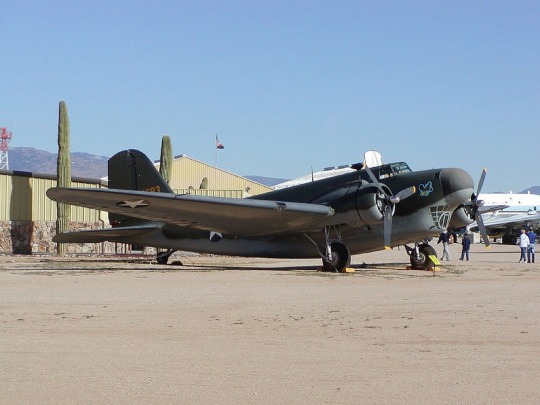#Douglas B-18 Bolo
Photo
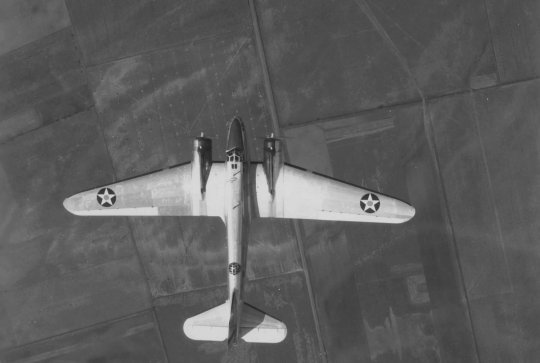
Vue aérienne d'un bombardier lourd Douglas B-18 Bolo – Mi 1930's
©United States Air Force
#Avant-guerre#Pre-war#Armée de l'Air américaine#United States Army Air Corps#USAAC#Aviation militaire#Military aviation#Bombardier#Bomber#Bombardier lourd#Heavy Bomber#Douglas B-18 Bolo#Douglas B-18#B-18#Bolo#1930's
92 notes
·
View notes
Text
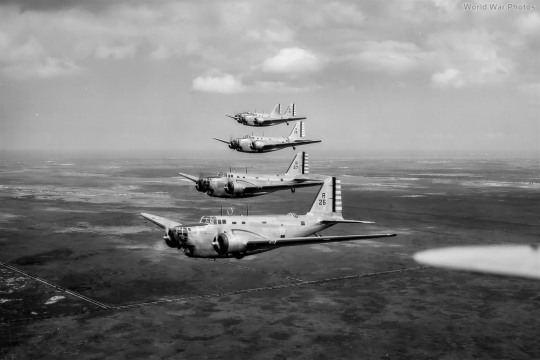
Douglas B-18 Bolo. 21st Reconnaissance Squadron. Nr Langley. April 1940
66 notes
·
View notes
Text

Loading bombs into a Douglas B-18 Bolo
@ron_eisele via X
30 notes
·
View notes
Photo
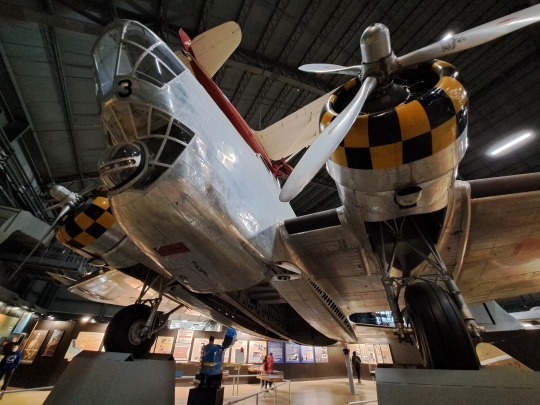
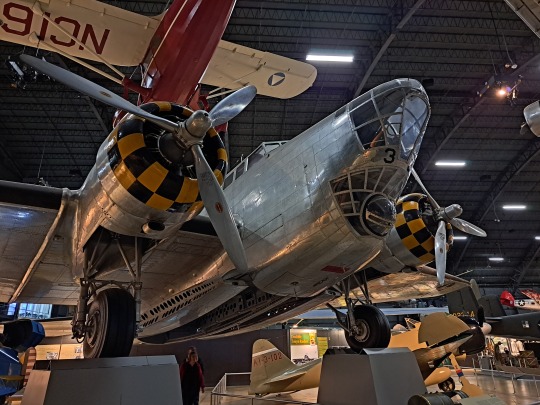
Douglas B-18 Bolo, NMUSAF.
10 notes
·
View notes
Text
Inspection of the Douglas B-18 Bolo bomber

8 notes
·
View notes
Video
Douglas B-18 Bolo by Willard Womack
Via Flickr:
The B-18 evolved from the Douglas DC-2. Many were destroyed at both Pearl Harbor and in the Philippines on seven December 1941. The old cars are not bad either. This is March Air Force Base California, 5 May, 1941.
75 notes
·
View notes
Text

-An F-4S painted in the Heater-Ferris scheme in 1983. | Photo: Keith C. Svendsen
FLIGHTLINE: 138 - HEATER-FERRIS CAMOUFLAGE
Tested by the US Navy and Air Force during the 70s and 80s, the Ferris and Heater-Ferris schemes sought to optimize the effectiveness of visual camo.
Carlisle Ferris, who goes by his middle name Keith, was born on 14 May 1929 in Honolulu while his father was stationed at Luke Field, Pearl Harbor. His father was then transferred to Kelly Field, Texas as a flight instructor before being moved again to March Field, California. There he was treated to a flight in a Douglas B-18 Bolo, which ignited a life-long fascination with aviation.
After WWII, Ferris enrolled in Texas A&M's aeronautical engineering program with the aim of getting commissioned in the USAF. When he found out that he was medically unable to become a pilot, he transferred to George Washington University to study anatomy and figure drawing. In 1951 he moved to St. Louis and worked as a contactor producing artwork for USAF training manuals. When the USAF closed the operation in 1956, Ferris moved to NYC to become a freelance artist for the aerospace industry, as well as participating with the Air Force Art Program. This program allowed him to fly on numerous USAF aircraft from the late 50s through to the 1990s, and in locations from Thailand to the Balkans. Ferris was one of the the program's most prolific artists, producing 62 paintings, along with two giant murals for the Smithsonian Institution's Air and Space Museum: "Fortresses Under Fire", which depicts the B-17 'Thunderbird' during its 70th mission, and "The Evolution of Jet Aviation", which is exactly what you'd think it is.

-In this 2005 photo, Keith Ferris stands before his mural “Fortresses Under Fire” at the National Air and Space Museum in Washington, D.C. | MarkBennett13
APPLIED THEORIES
Seeking to combine his knowledge of aircraft and his artistic talent, Ferris went on to develop and patent several camouflage ideas, including painting a false canopy on the bottom of an aircraft to confuse opponents, and another involving asymmetrical, splintered patterns of gray. Another change was reducing the size of aircraft marking, as well as making them gray, black or white.

-A Republic A-10 Thunderbolt II with a false canopy on the underside. | Photo: USAF
The Ferris scheme was applied to several early F-14s and F-15s for testing, with mixed results.

-A painting guide for a model F-14, showing the splintered pattern of Gunship Gray, Dark Gull Gray and Gull Gray. | Illustration: Don Color

-An F-14 painted in a Ferris scheme. | Photo: US Navy

-Two Farris painted F-14s deployed on a carrier. | Photo: US Navy

-Painting guide for a USAF F-15 in a different scheme of Dark Gull Gray, Gull Gray and Camouflage Gray. | Illustration: Don Color

-An F-15 painted in the above scheme. | Photo: USAF
Later, Lt Commander Chuck "Heater" Heatley of the Naval Fighter Weapons School ("Top Gun") made some changes to the basic Ferris scheme, simplifying the pattern and running the various shades of grey across the entire aircraft. Two F-4S squadrons adopted the Heater-Ferris scheme, VF-301 ("Devil's Disciples") and VF-302 ("Stallions").

-One of the VF-301 F-4s in the Heater-Ferris scheme. | Photo: Keith C Svendsen
Experiments with the Ferris and Heater-Ferris schemes proved that they did work at reducing the range at which an aircraft could be seen, as well as disguising the direction of travel, but the usefulness of visual camo was being deemphasized in an age of radar guided BVR missiles, though the F-15 and F-16 have worn other schemes influenced by Ferris.

-A USAF F-16 showing multi-shade pattern camouflage, influenced by Ferris. | Photo: USAF
Now retired, Ferris and his wife operate a small online business, offering his original art and prints of his work for sale.
#airplanes#aircraft#airplane#aviation art#aviation history#avgeek#aviation#cold war history#coldwar#cold war#usaf#us navy#keith ferris#heater ferris camouflage#f14tomcat#f14#mcdonnell douglas f15#boeing f15#f15#grumman f14
166 notes
·
View notes
Photo

Douglas B-18 Bolo
83 notes
·
View notes
Text
Things I Like • Vintage WW2 US Quilted Flying Pants
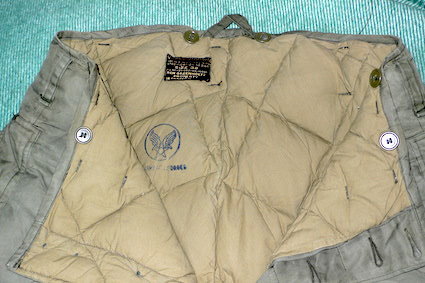
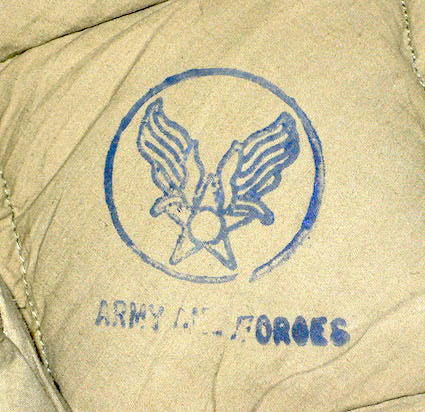

My friend Ben, who runs the specialist vintage menswear shop at the top of the street, found these.
I’d never seen this kind of thing before - they are quilted and goose-down filled trousers for US Army Air Forces air-crew from WW2. This isn’t normally my thing, but I love the quilted effect and the printed USAAF mark.
The trousers are the model A8 and made by the Ben Greenholtz Company.
These trousers were for winter and high-altitude use...and were worn by the crews of the Flying Fortresses of the 8th Army Air Force...that’s the Memphis Belle etc. I guess these kinds of trousers were made in quite large numbers and over a period of time. The USAAF became the USAF at the end of the 1940s.
I remember that there was a scale model of the B17 available from Airfix. The box had a terrific picture on the front, and the graphic signs of the Fortress were really impressive. I found the information, below, on a website devoted to scale modelling
https://www.scalemodellingnow.com/hnaircraft-airfix-boeing-b17g-flying-fortress



The Boeing B-17 Flying Fortress was a four-engine heavy bomber developed in the 1930s for the United States Army Air Corps (USAAC). Competing against Douglas and Martin for a contract to build 200 bombers, the Boeing entry (prototype Model 299/XB-17) outperformed both competitors and exceeded the air corps’ performance specifications. Although Boeing lost the contract (to the Douglas B-18 Bolo) because the prototype crashed, the air corps ordered 13 more B-17s for further evaluation. From its introduction in 1938, the B-17 Flying Fortress evolved through numerous design advances.
The B-17 was primarily employed by the United States Army Air Forces (USAAF) in the daylight strategic bombing campaign of World War II against German industrial and military targets. The United States Eighth Air Force, based at many airfields in central and southern England, and the Fifteenth Air Force, based in Italy, complemented the RAF Bomber Command’s nighttime area bombing in the Combined Bomber Offensive to help secure air superiority over the cities, factories and battlefields of Western Europe in preparation for the invasion of France in 1944. The B-17 also participated to a lesser extent in the War in the Pacific, early in World War II, where it conducted raids against Japanese shipping and airfields.
From its prewar inception, the USAAC (by June 1941, the USAAF) promoted the aircraft as a strategic weapon; it was a relatively fast, high-flying, long-range bomber with heavy defensive armament at the expense of bomb load. It developed a reputation for toughness based upon stories and photos of badly damaged B-17s safely returning to base. The B-17 developed a reputation as an effective bomber, dropping more bombs than any other U.S. aircraft in World War II.






Crew losses were high...and many of the crew were young lads. The crew was made up of 10. You can watch the film, Memphis Belle (1990) for a sense of the danger and heroism associated with this effort. There’s a documentary film, available from the US Library of Congress - Story of a Flying Fortress (1944) which places these machines within the context of the European war and bucolic England...Margaret Bourke White made a terrific photo-shoot of “The Mighty Eighth” for Life Magazine.
https://youtu.be/DW4F_ZMrS3A

Here is a one of our vintage WW2 scarves with the names of some of the most famous flyers. There is a Fortress displayed at the American Air Force Museum at Duxford. The Fortress, a big machine, sits beneath the wing of a Superfortress B29, which is placed beneath a Stratofortress B52 bomber. The building of the museum was designed by Foster and Partners.
I am always freezing cold, so these will keep my nice and warm at home, watching TV. Our central-heating boiler broke down just before New Year and to coincide with the coldest weather of the season. So, these pants have come in to their own. Thank you Ben.
0 notes
Photo

The ghost of Tribulation Littlefield, a one-time fur trader, train robber, bootlegger, sharpshooter and gossip columnist for Cowhand Confidential, surveys a line of WW2 bombers at the Savannah Army Air Base in Hinesville, Georgia, in this thoughtful postcard from 1943.
Though Littlefield had died years before the plane’s development, when World War Two was just a twinkling in Adolf Hitler’s eye, the cowboy’s incorporeal spirit loved the Douglas A-20 Havoc, appreciating the light bomber as a scrappy, dependable combat aircraft with a well-deserved reputation for speed and agility.
No fan of the Douglas B-18 Bolo medium bomber, Littlefield once described it as “so ugly it could back a buzzard off a gut-wagon,” the same phrase he used in describing rival columnist Hedda Hopper.
#baby gruenwald#old postcard#vintage postcard#ghost#cowboy#fur trader#train#train robber#bootlegger#bootlegging#sharpshooter#columnist#ww2#world war two#hitler#savannah#supernatural#bomber#army
5 notes
·
View notes
Photo


Un Douglas B-18 Digby (surnom canadien du B-18 Bolo) du 10e Escadron de Bombardement de la Royal Canadian Air Force (North Atlantic Squadron) crashé dans la baie de Dover après que le moteur tribord ait pris feu est remorqué par les membres d'équipage et les habitants – Terre-Neuve-et-Labrador – Canada – 2 janvier 1942
Le 10e Escadron de Bombardement a été créé le 5 septembre 1939 par la RCAF pour la lutte anti-sous-marine en Atlantique Nord.
#WWII#Bataille de l'Atlantique#Royal Canadian Air Force#RCAF#10e Escadron de Bombardement RCAF#North Atlantic Squadron#Aviation militaire#Bombardier#Bombardier moyen#Avion de lutte anti-sous-marine#Douglas B-18 Bolo#Digby#Baie de Dover#Dover#Terre-Neuve-et-Labrador#Canada#02/01/1942#01/1942#1942
61 notes
·
View notes
Photo

Douglas B-18A Bolo. At rest at an airfield in Panama, 1943. First flew 1935. Designed to replace the Martin B-10 and based on the DC-2. 350 were built
42 notes
·
View notes
Photo

Douglas B-18 Bolo, I’d love to have seen one fly. National Museum of the United States Air Force.
84 notes
·
View notes
Photo

The prototype bomber Douglas XB-11, evolved over time into a serial B-18 "Bolo". February 1937.
17 notes
·
View notes
Video
Untitled by Willard Womack
Via Flickr:
An interesting group of wannabes. Far left, in the rear, is a Douglas B-18 Bolo. Next a Douglas B-23 Dragon, and last two Bell FM-1 Airacudas. Only the Bolo saw any service with many being destroyed at Pearl Harbor. Later some became coast watchers. The B-23 was fast, with some becoming business planes after the war. The Airacuda was a dud.
6 notes
·
View notes
